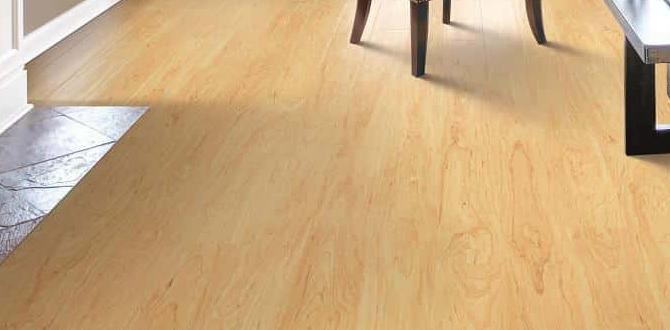Use a nail gun for window casing by choosing the right type, prepping your workspace and materials, and following a simple step-by-step nailing process. This guide simplifies the task, ensuring a professional finish even for beginners. Master this technique for durable and attractive window trim.
Adding a finishing touch to your windows can make a big difference in your home’s appearance. Whether you’re replacing old trim or installing new windows, getting that clean, professional look often comes down to the little details. One of those details is how you attach your window casing. While many might think of hammers and nails, a nail gun can make this job much faster and easier, especially if you’re new to this kind of project. Don’t worry if you’ve never used one before; I’m here to walk you through it step-by-step. We’ll cover everything you need to know, from picking the right nailer to securing your casing perfectly.
Table of Contents
Why Use a Nail Gun for Window Casing?
Let’s talk about why using a nail gun is a smart move for your window casing project. It’s not just about speed, though that’s a big plus. A nail gun drives fasteners consistently, which means fewer bent nails and a much cleaner look. For DIYers, this consistency is key to achieving professional results without years of practice.
Here are a few reasons why a nail gun is your best friend for this task:
Speed: You can install casing much faster than with a hammer.
Consistency: Each nail is driven to the same depth, leading to a uniform look.
Reduced Fatigue: Less physical strain means you can work longer and more comfortably.
Cleaner Finish: Fewer mistakes like over-driven or partially driven nails.
Better Hold: Nails typically provide a stronger hold than staples or glue alone.
Choosing the Right Nail Gun
Not all nail guns are created equal, and picking the right one for window casing is crucial for success. For interior trim work like window casing, you generally want a tool that’s lightweight, accurate, and designed for smaller fasteners.
The Brad Nailer vs. The Finish Nailer
This is where many beginners get a little confused. Both are excellent for trim, but they have subtle differences:
Brad Nailer: These use very thin nails, often referred to as “brads.” They are great for delicate moldings and situations where you want minimal damage to the wood. The holes they leave are tiny, making them easier to fill.
Finish Nailer: These use slightly thicker, “finish nails.” They offer a bit more holding power and are suitable for larger pieces of trim or areas that might experience more stress.
For window casing, a 16-gauge finish nailer is usually the go-to choice. It’s robust enough to hold the casing firmly in place, but the nails are slim enough that the holes are relatively easy to hide. A 18-gauge brad nailer can also work, especially for very narrow or delicate casing, but you might need to be more strategic with nail placement for a secure hold.
Power Source:
Nail guns come in a few types based on their power source:
Pneumatic (Air-Powered): These are the most common in professional settings. They require an air compressor, hose, and typically offer the most power and reliability. They are often lighter in hand than electric models.
Electric (Corded): These plug into a standard outlet. They are convenient as they don’t require an air compressor, but they can be heavier and may have less power than pneumatic models, which could be a concern for tougher woods.
Battery-Powered (Cordless): These are powered by batteries. They offer ultimate portability and convenience, eliminating the need for cords or compressors. Battery technology has come a long way, making them a great option for DIYers and professionals alike.
What I Recommend for Window Casing:
For most DIYers tackling window casing, a cordless 16-gauge finish nailer is an excellent choice. It balances power, convenience, and precision perfectly. If you already have a pneumatic setup, an air-powered 16-gauge finish nailer is also a fantastic option.
Gathering Your Tools and Materials
Before you even think about firing a nail, let’s make sure you have everything you need. Being prepared saves time, frustration, and potential trips to the hardware store mid-project.
Essential Tools:
Nail Gun: As discussed, a 16-gauge finish nailer is highly recommended.
Air Compressor and Hose (if using pneumatic): Ensure the compressor has enough CFM (Cubic Feet per Minute) for your nailer.
Nails: Use the recommended gauge (e.g., 2-inch 16-gauge nails for standard casing). Make sure they are the correct length for your casing thickness and desired penetration.
Safety Glasses: This is non-negotiable! Always wear safety glasses to protect your eyes from flying debris or ricocheting nails.
Hearing Protection: Nail guns can be loud. Earplugs or earmuffs are a good idea.
Measuring Tape: For accurate measurements of your casing.
Pencil: For marking measurements and nail placement.
Miter Saw: Essential for cutting your casing pieces accurately at 45-degree angles.
Compound Miter Saw: This is even better, as it allows for more complex angle cuts if your trim design requires it.
Chisel or Nail Set (Optional): For sinking nails that are slightly proud of the surface.
Wood Filler or Putty: To fill nail holes after you’re done.
Caulk: To fill gaps between the casing and the wall or window.
Stud Finder: To locate wall studs for secure fastening.
Clamps (Optional but helpful): To hold casing in place while nailing.
Materials:
Window Casing: Choose a style and material that complements your home’s decor.
Wood Glue (Optional but recommended): For extra strong joints at the corners.
Preparing Your Workspace and Casing
A little preparation goes a long way. Setting up your space correctly and preparing your trim pieces will ensure a smoother, more professional finish.
1. Clear the Area: Remove any furniture or decor that might be in the way. You’ll need plenty of room to work around the window.
2. Safety First: Make sure your safety glasses are on and that your workspace is well-lit. If using a pneumatic nailer, connect your air hose and set the compressor pressure according to your nailer’s manual. Most finish nailers operate efficiently between 90-120 PSI.
3. Inspect Your Casing: Look for any imperfections, knots, or damage. Plan your cuts to avoid these if possible, or ensure they are in less visible areas.
4. Measure and Cut: This is where precision is vital. You’ll typically miter the top corner of your side casing pieces at 45 degrees to meet the head piece. For a basic box casing, the two side pieces will have a 45-degree miter cut on the top end, slanting inwards. The two ends of the head piece (the top piece) will have 45-degree miter cuts that slant outwards.
A common technique is to measure the length of the inside opening of your window frame. Add the width of your casing to each side of this measurement to determine the overall length of your side pieces. For the top piece, measure the width of the inside opening and add twice the width of your casing. Always double-check your measurements before cutting!
5. Dry Fit: Before you nail anything, hold your cut pieces up to the window opening. Ensure they fit snugly and the angles are correct. Make any necessary adjustments now. This step can save you a lot of headaches and wasted material.
How to Use a Nail Gun for Window Casing: Step-by-Step
Now for the fun part! Using a nail gun might seem intimidating, but it’s quite straightforward once you understand the process. Remember, safety and controlled application are key.
Step 1: Set Up Your Nail Gun
Load Nails: Open the magazine of your nail gun and insert the correct type and size of nails. Make sure they are seated properly. Close the magazine firmly until it latches.
Adjust Depth Setting: Most nail guns have an adjustable depth setting. You want the nail to sink just slightly below the surface of the wood, leaving a small dimple that can be easily filled. Test this on a scrap piece of your casing material first. Start with a medium setting and adjust as needed. Too deep, and you’ll damage the wood. Too shallow, and the nail head will stick out.
Set Air Pressure (Pneumatic): Ensure your compressor is set to the manufacturer’s recommended PSI for your nailer. This is usually between 90-120 PSI.
Step 2: Position the Casing
Place your first piece of casing against the wall and window frame.
Make sure it’s flush against the wall and lines up perfectly with your previous cuts.
If you’re using wood glue on your joints, apply a thin bead to the mitered edges before positioning.
For longer pieces or awkward angles, using clamps can help hold the casing securely in place while you nail.
Step 3: Nailing Techniques
Safety Engage: Press the nose of the nail gun firmly against the surface of the casing where you intend to drive a nail. Most modern nail guns have a safety contact tip; you must press this against the wood before you pull the trigger. This prevents accidental firing.
Aim and Fire: Pull the trigger. The nail should drive into the wood.
Placement is Key:
Place nails approximately 6-8 inches apart.
Nail into the frame of the window and into the wall studs for maximum stability. Use a stud finder to locate studs behind the drywall.
Be careful not to place nails too close to the edge of the wood, as it can split, especially with hardwoods.
For mitered corners, drive a few nails into the main body of the casing, and then one or two into the mitered joint itself to ensure a tight fit against the wall and frame.
Controlled Firing: For the first few nails on a new piece, it’s wise to place them deliberately rather than “bouncing” the gun (rapidly firing multiple nails without repositioning). This ensures accuracy and avoids mistakes. Once you’re confident with the placement, you can use the bump-fire mode (if available and you feel comfortable) for faster installation.
Step 4: Nailing Through Different Materials
Into Wood Frame: This is the easiest. The nail should drive in smoothly.
Into Drywall/Plaster: The nail will go through the casing and into the wood stud behind the wall. You need to ensure your nails are long enough to penetrate the casing and get a good grip in the stud. If you miss a stud, the nail won’t have much holding power in drywall alone. This is why locating studs is so important.
Into the Window Frame: Casing is typically nailed into the window frame itself for a secure fit. Ensure your nail lengths are appropriate so you don’t puncture the glass or metal components of the window unit.
Step 5: Final Touches
Check for Sunk Nails: After nailing, inspect all the nails. If any are slightly proud of the surface or not fully sunk, use a nail set and hammer to gently tap them flush or just below the surface.
Fill Nail Holes: Once all your casing is installed, you’ll need to fill the nail holes. Use a good quality wood filler or putty. Choose a color that matches your casing or is paintable if you plan to paint.
Caulk Gaps: Use paintable caulk to fill any small gaps between the casing and the wall, or between the casing and the window frame. This creates a seamless look and prevents air drafts.
Sand and Finish: After the wood filler and caulk have dried, lightly sand the filled areas smooth. Then, prime and paint or stain your casing as desired.
Nail Gun Safety and Best Practices
Working with power tools always requires a mindful approach to safety. Nail guns are powerful tools, and using them correctly ensures you and those around you stay safe.
Always Wear Safety Glasses: I can’t stress this enough. It’s the number one rule.
Never Point the Nail Gun at Anyone: Treat it with the same respect you would a firearm.
Keep Fingers Away from the Trigger: Don’t rest your finger on the trigger while handling the nail gun.
Disconnect Power When Not in Use: For pneumatic nailers, disconnect the air hose. For electric or battery models, remove the battery or unplug it from the power source when loading, adjusting, or clearing jams, and when walking away from the tool.
Understand Your Nailer: Read the owner’s manual thoroughly. Familiarize yourself with its specific safety features and operating instructions.
Use the Safety Contact Tip: Ensure this is engaged against the workpiece before pulling the trigger.
Avoid Over-Pressurizing: Use the recommended air pressure for pneumatic nailers. Too much pressure can cause nails to over-penetrate or ricochet.
Clear Jams Safely: If a nail gets jammed, disconnect the power source before attempting to clear it. Consult your tool’s manual for specific instructions.
* Work in a Well-Ventilated Area: Especially if using glues, paints, or finishes.
Common Issues and Troubleshooting
Even with the best preparation, you might run into a few hiccups. Here’s how to address common problems when using a nail gun for window casing.
| Problem | Possible Cause | Solution |
| :————————— | :——————————————– | :————————————————————————————————————————————————————————————————– |
| Nails not firing | No power/air | Check air hose connection (pneumatic), battery charge (cordless), or power cord (electric). |
| | Safety contact tip not depressed | Press the nose of the gun firmly against the wood. |
| | Jammed nail | Disconnect power/air, clear the jam following the manual. |
| Nails not sinking deep enough | Low air pressure (pneumatic) | Increase compressor setting. |
| | Depth setting too shallow | Adjust the depth setting on the nail gun. |
| | Wrong nail size/type | Ensure you’re using the correct gauge and length nails for your material and nailer. |
| Nails sinking too deep | Air pressure too high (pneumatic) | Decrease compressor setting. |
| | Depth setting too deep | Adjust the depth setting on the nail gun. |
| Wood splitting | Nails too close to edge | Move nail placement further from the edge. |
| | Air pressure too high (pneumatic) | Reduce air pressure. |
| | Driving nails into knots or hard grain | Pre-drilling a small pilot hole can help in very tough spots, but try to avoid nailing directly into knots. |
| | Incorrect nail size | Thicker nails can be more prone to splitting; ensure you’re using the recommended gauge. |
| Casing moving while nailing | Not holding piece steady | Use clamps to secure the casing. Ensure you’re pressing the nail gun firmly into the wood. |
Frequently Asked Questions (FAQ)
Q1: What is the best type of nail gun for window casing?
A1: A 16-gauge finish nailer is generally the best choice for window casing. It drives nails that are substantial enough for a secure hold but slim enough to minimize visible damage, making them easy to fill and conceal.
Q2: What nail size should I use for window casing?
A2: For standard interior casing (around 1/2 to 3/4 inch thick), 2-inch long nails are typically recommended. Always check the specifications for your chosen casing and nailer, and ensure the nails penetrate sufficiently into the wall studs for a secure attachment.
Q3: How far apart should I place nails when installing window casing?
A3: A good rule of thumb is to place nails about 6 to 8 inches apart. You’ll also want to make sure you’re nailing into the window frame for support, as well as into the wall studs for long-term stability.
Q4: Can I use a brad nailer for window casing?
A4: Yes, you can, especially for thinner or more delicate casing profiles. However, a 18-gauge brad nailer uses very thin nails, which may not offer as much holding power as a 16-gauge finish nailer. You might need to use more nails and be extra diligent about hitting studs.
Q5: What air pressure should I set my compressor to for a finish nailer?
A5: Most 16-gauge finish nailers operate effectively between 90 and 120 PSI (pounds per square inch). Always refer to your specific nail gun’s user manual for the recommended pressure range.
Q6: How do I ensure the nails don’t split the wood?
A6: To


